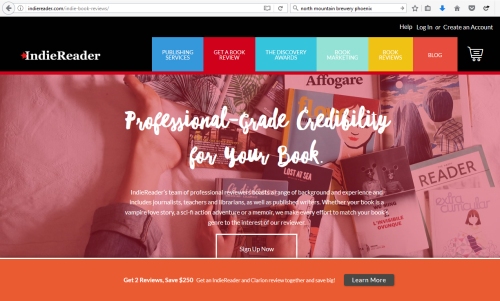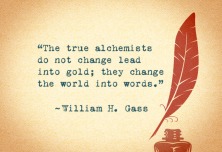Are your branding and marketing message cohesive?
A client recently forwarded me information about a relatively new book distribution company he was thinking about checking out. I did a cursory scan of the website and noticed an odd thing right off the bat: its use of this decorative font that, while pretty, is very difficult to read.

Coupled with the busy picture backdrop and the text that gets lost in that picture, it makes for a pretty unsuccessful sales page. That seems to be a preferred headline font throughout the site. Red Flag No. 1.
With that, I send this response to my client:
This may sound really peculiar, but I would doubt this company’s ability to deliver, just based on that crazy font they used for their headlines. It may be pretty, but it’s really difficult to read, which means it’s impractical. If that’s the choice for their own marketing, it causes me to question the rest of their planning and strategies.
That was when I decided to write this post. But first, I went back and delved a little deeper into IndieReader.

Among other things, it offers a service that promises to get books “in front of [as many as] 37,000 industry professionals.” Yes – that’s what that tiny line in the super curly fancy font says. No word on who the professionals are. Truly, the gal who answers the phone or the intern who reads the slush pile could be classified as an industry professional. Red Flag No. 2.
The third line on their service description page smartly plays to the author’s ego: Sure your friend may have downloaded the Kindle version of your book, but you know what you really want is to see your book in bookstores!
If you know anything about what it takes to get into a bookstore, one of your first questions should be about the return policy. When you sell books to a bookstore, they are essentially bought on consignment. That is, most bookstores require authors to accept the return of unsold books – meaning the authors have to buy them back from the store. Imagine how careful you’d be when sending your books off to the store – or how nicely they’d be packaged if they were being drop-shipped straight from the printer. The idea being that they’d arrive in pristine shape, ready to go on the shelf.
Now imagine a $10/hour college student pulling your unsold books off the same shelf – assuming they ever actually made it onto the shelf in the first place – and throwing them, willy-nilly, into a box that gets shipped back to you. Covers bent, pages torn – do they care? Not a whit. This is what is often involved in agreeing to a store’s return policy.
But when I clicked the link to See IR In-Store FAQs to learn more about how IndieReader deals with stores’ return policies, I was greeted with the following 404 error screen. Red Flag No. 3.

Now I don’t know anything more about this company than what I’ve written here. But based on what I’ve seen, I would not advise my client – or anyone, for that matter – to use them. At least not without a huge amount of due diligence, including insisting on talking to a half-dozen of their previous clients.
Most people think of branding as a logo – but it goes much further than that. Branding does involve your logo, but it also involves your tagline, your color scheme, the look and feel of your website, blog, social media, and marketing collateral. And most importantly, it is comprised of your promised deliverables – and then how you execute on that promise.
Are your branding decisions cohesive? Are they communicating the message you want them to convey to your readers, fans, visitors, and prospective buyers? If you’re known for writing paranormal thrillers today, but you direct people to an old website designed to sell your erotic poetry, they won’t stick around long enough to dig through and find the new books. If you’re promising to deliver excellent info about helping folks overcome addictions, you need to make sure nothing in your branding gives prospective readers/clients a reason to doubt you.
Whatever you’re writing, make sure that all of your marketing materials – both on- and offline – are coherent and represent you as well as possible.
Happy marketing!
Laura
__________________
We welcome and encourage your thoughtful, courteous comments below.
__________________

Learn the steps that will set you apart from 95% of all new authors.
(Hint: It’s NOT too late, even if you’ve already placed your first printing order for books!)
__________________




















Great tips on what to look out for. Thanks for sharing.
Thanks for reading – and subscribing, Jean!
Mine are a lot more cohesive than they used to be although not perfect, but then perfect wouldn’t be on brand for me 🙂
I love that you know that messaging that’s just a bit imperfect is a part of your branding, Linda!
It took a long time to get to that realization 🙂
Now the AUTHENTIC marketing begins!
Yes, peeling away layers
Yes, great points. I’m in the process of cleaning my online presence as well. Plus these passwords to even make a comment! Thanks for the reminder pushing me to figure it out.
Alecia, I try not to use moderation b/c I don’t want anyone to jump through hoops to post comments, but then the jackass spammers come flying in. So … minimal extra steps for the readers to save my own sanity. Thanks for reading and commenting!
Due diligence before engaging with a company is so important. And this is a great reminder to review our own content and branding choices. Getting an outside perspective (like yours on the Indie Reader site) can go a long way to helping ensure we come across the way we intend.
I think a lot of entrepreneurs – and small companies – are so excited to just get up and running that they skip important steps in the branding process. It’s probably better to do something than suffer from analysis paralysis and never get it off the ground, but I’d hope more would strive for the balance between both expedience and due diligence. Thanks for reading and commenting, Michelle!